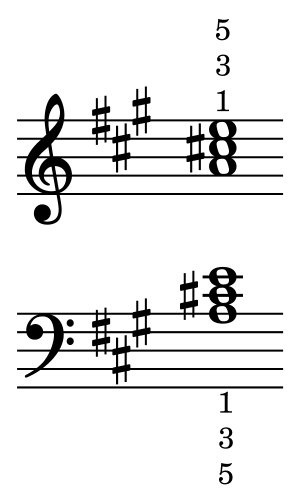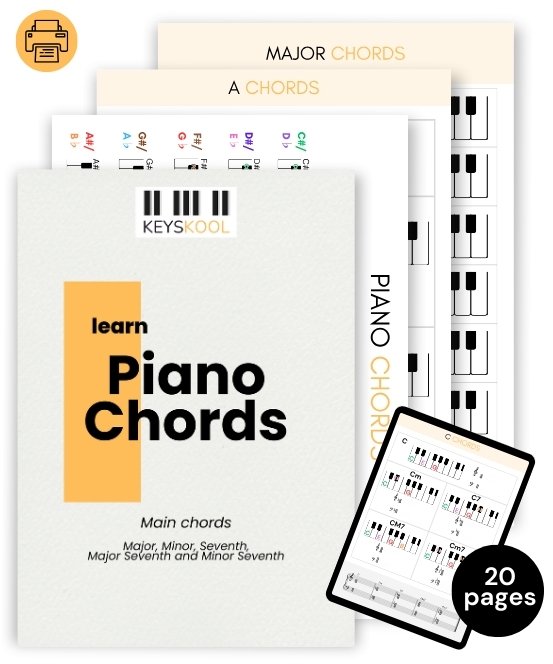The importance of piano chords A
Mastering the A chord on the piano is a fundamental step for beginners.
As one of the simplest chords, it serves as an excellent starting point for understanding harmonic structures. It’s also one of the common and simple piano chords in many popular songs, making it practical for beginners to learn.
By starting with piano chords A, you can begin to understand the relationship between different notes and how they come together to create a pleasing sound. This foundational knowledge can then be applied to more complex chords and techniques, accelerating your progress in learning the piano.
Composition of the Piano Chord A major

The A Major chord, often abbreviated as A, is a triad, meaning it is composed of three notes. These three notes are A, C#, and E:
- A is the root note, which gives the chord its name. This is the base of the chord and usually the lowest note when played.
- C# is the third of the chord. The term ‘third’ refers to the interval from the root. In a major chord like A, the third is a major third, which means it is four half-steps above the root.
- E is the fifth of the chord. The fifth refers to its interval from the root. In major chords, the fifth is always seven half-steps above the root.
Together, these three notes create a pleasing harmonic sound, which is distinctive of major chords. The A chord is a popular and frequently used chord in many songs across various genres and therefore in many piano chords easy songs for beginners.
Fingering of piano chords A major

Right Hand
- Start by positioning your thumb (1st finger) on the A note. This is typically the white key directly to the right of the group of three black keys.
- Place your middle finger (3rd finger) on the C# note, which is the black key located directly to the right of the C note.
- Lastly, position your little finger (5th finger) on the E note.
Practicing this positioning can be achieved by playing the chord in sequences or arpeggios, slowly at first, then gradually increasing the speed as your comfort and familiarity with the chord increase.
Left Hand
- Position your little finger (5th finger) on the A note.
- Place your middle finger (3rd finger) on the C# note.
- Lastly, your thumb (1st finger) should be on the E note.
As with the right hand, practice this chord by playing it in sequences or arpeggios, and increase the speed as you become more comfortable.

Common Challenges and Solutions for Playing Chord A
As a beginner, you might encounter certain challenges when trying to play the A chord. Don’t worry, these are common hiccups that can be overcome with understanding and practice.
- One of the most common difficulties is not pressing the keys hard enough or holding them down long enough. This can result in a weak or stuttering sound. The solution to this is to practice pressing the keys with enough force and holding them down for the right duration. This will help in producing a clear and consistent sound.
- Another challenge is finger positioning. It’s crucial to ensure that your fingers are correctly positioned on the keys to play the A chord. Incorrect finger positioning can lead to wrong notes being played. One helpful tip is to use a piano chord chart or watch tutorials to understand the correct finger positions.
- Lastly, you might find it hard to transition from the A chord to other chords smoothly. This is a normal part of learning and becomes easier with practice. One effective practice strategy is to repeatedly transition between the A chord and other common chords. This would not only increase your familiarity with the A chord but also improve your overall chord transitioning skills.
Remember, mastering any skill takes time and patience. Regular practice will help you overcome these challenges and make playing the A chord second nature to you.
Read: The Importance of Chord Knowledge for Pianists – Making Music Mag
Tips to Practice the A Chord
- Start Slowly: When first learning a new chord, it’s essential to start slowly. This allows you to focus on finger placement and ensures you’re playing each note correctly.
- Practice Regularly: Consistency is key when learning to play an instrument. Try to incorporate chord practice into your regular routine.
- Use a Metronome: A metronome can help you keep a steady pace when practicing your chords. Start at a slow speed and gradually increase as you get more comfortable.
- Chord Progressions: Once you’re comfortable playing the A chord, try practicing chord progressions. This will help you understand how different chords sound together and prepare you for playing songs.

Most famous songs with piano chords A
- “Let It Be” by The Beatles – Chords used: C, G, A, F
- “Imagine” by John Lennon – Chords used: C, E, F, A
- “Someone Like You” by Adele – Chords used: A, E, F#m, D
- “Hey Jude” by The Beatles – Chords used: F, C, A, G
- “Don’t Stop Believin'” by Journey – Chords used: E, B, C#m, A
- “I’m Yours” by Jason Mraz – Chords used: G, D, Em, A
- “Hallelujah” by Leonard Cohen – Chords used: C, Am, F, G, E, A
- “No Woman, No Cry” by Bob Marley – Chords used: C, G, Am, F, A
- “Viva la Vida” by Coldplay – Chords used: C, D, G, Em, B, A

